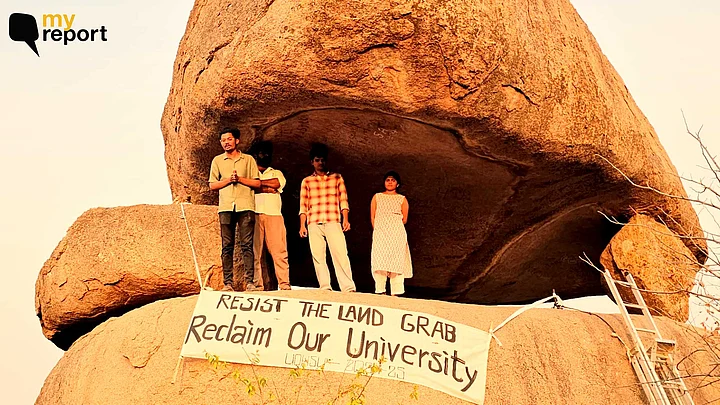Mushroom Rock, located within the Hyderabad Central University (HCU) campus, is not just a rock formation. It is a cultural, ecological, and nostalgic site for the HCU community—and part of the university's academic, social and environmental fabric.
I first learned about the decision of the Congress-led Telangana government to auction off nearly 400 acres of university property in Kancha Gachibowli village under Serilingampally Mandal when pictures of bulldozers levelling land around the Mushroom Rock started circulating in our WhatsApp groups.
Soon after, this plan to sell off the land – supposedly under the name of “revenue generation” and “sustainable development” – drew widespread criticism among students and teachers alike.
The peril of its destruction advanced concern regarding the government’s priorities and what lies in future for the university’s natural heritage. Thus, the Hyderabad Central University Students’ Union (HCUSU) issued a call for a protest gathering on 13 March to fight against their decision.
'Won't Let Our Heritage Be Perished'
I arrived at the meeting point near the university's Economics Department at approximately 10:30 am. A huge gathering of students was already present.
Undeterred by the blazing heat, the response was enormous. The students began chanting slogans against the bulldozing and to save Mushroom Rock. Placards and tambourines became an integral part of our protest.
Around 11:00 am, the students progressed in a marching order towards Mushroom Rock as their slogans of “Hands Off HCU Land” and “Save Mushroom Rock” reverberated through the campus.
As we reached the site, the scale of the protest became further evident.
Hundreds of students had assembled—and the atmosphere was one of willpower and camaraderie. The students’ union had set up a temporary tent to provide shade, along with provisions of water and food.
One by one, the leaders of the students’ union, including the president, the vice-president, the general secretary, and the joint secretary – addressed the gathering. Their speeches were mostly aimed at the government’s decision, which they classified as a "land grab disguised as development". They raised their voice against the lack of lucidity in the process and questioned the motive behind targeting such an environmentally and ecologically sensitive area.
The silence of the students’ wing of the Congress party was also questioned, with calls for better responsibility from the students’ organisations.
Students then planted saplings on the disputed land, stressing their determination to keep the ecological poise of the area intact. A banner was also draped around Mushroom Rock, asserting the ownership of the land by the Hyderabad Central University.
Their gestures conveyed a strong message: the HCU community would not let its heritage be perished.
'A Testament to the Unity of HCU Community'
The University of Hyderabad Teachers' Association, Non-Teaching Staff Union, and the Workers' Union showed their strong solidarity to students. Representatives from different unions addressed the crowd, providing insights into the history of the place. Their camaraderie brought consideration to the greater inference of the matter beyond the HCU community to encompass everyone in the campus.
The protest went on for about six to seven hours. As the day progressed, a Joint Action Committee (JAC) comprising representatives of the students' union, Workers' Union, Non-Teaching Staff Union, and Teachers' Association was constituted.
The directive of the JAC is to negotiate with the university administration, instigate legal actions for stopping the auction, and stop any imminent infringement of the university’s land. This was a huge step forward in the scuffle to protect the land of the university.
The protest is a huge testament to the unity and fortitude of the HCU community. It not only highlighted the importance of Mushroom Rock but also raised the issue of land rights at large on campus.
The path forward might be tough but the formation of the JAC and the united efforts of students, faculty, and staff offers assurance for a victorious conclusion.
As I look back at the events that unfolded on 13 March, I am reminded of the strength of coming together. The protest in my eyes was never just about saving a patch of land—it was also to break the conviction that students will stay silent regardless of whatever happens surrounding them. They won't.
(The author is a first-year student of MA Communication.)
TGIIC's Land Development Plans
The Telangana State Industrial Infrastructure Corporation (TGIIC), which had called for bids, said the auctioned land will be developed to include commercial and residential buildings, public parks, walkways, cycling trails, heritage- and culture-based eco-parks, and amenity zones. It is to be noted that the land came back into the state government’s possession only last year after a 20-year-long court battle, according to The News Minute.
(All 'My Report' branded stories are submitted by citizen journalists to The Quint. Though The Quint inquires into the claims/allegations from all parties before publishing, the report and the views expressed above are the citizen journalist's own. The Quint neither endorses nor is responsible for the same.)
